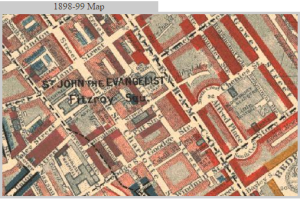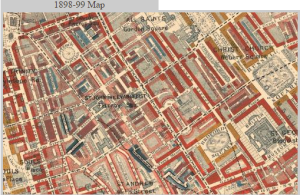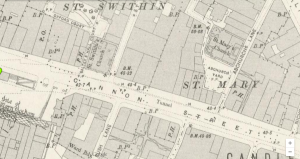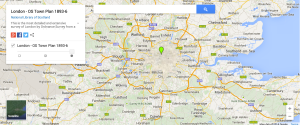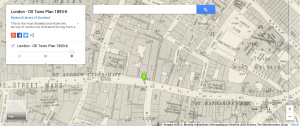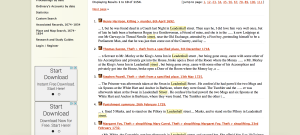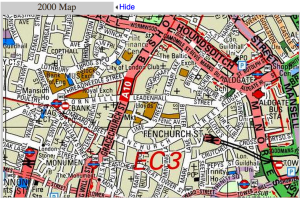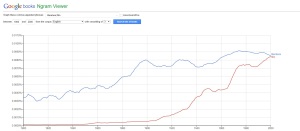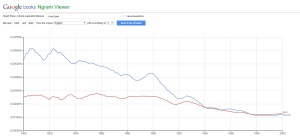http://gai.omeka.net/
Class Blog 1
What Makes a Good DH Project?
Qualities of a good DH project:
1. Research. It’s not enough to know your results, it’s important you know what factors could have caused these results.
2. An interesting topic.
3. Proper use of the tools.
4. Pictures or visuals of the data. It helps to include the graphs you received to show your results.
5. An explanation of what these results mean or say about the topic.
A DH project is good when the presenter of the project is interested in the topic they are presenting. When someone is interested in their topic, they will go above and beyond the assignment. Someone who is interested in their project will delve deeper to find more and more information about what they’re presenting. Additionally, it makes for a better presentation. Watching someone present about something they’re passionate about is infinitely better than watching someone who has no further interest in their topic.
DH is constantly finding new information and broadens the horizons. New information opens the door for new questions to be asked and new possibilities to be studied. People who study DH are people who want to look at graph and information from all perspectives. Graphs, databases, and archives often don’t only give us information, they give us new questions to be asked. They answer one question that opens the possibility for a million further questions.
Blog Post
A list of 5 qualities of a good DH Project.
1. Easy to read/use
2. Interactive and Informative
3. All sources cited
4. Should be able to be used as an academic source
5. Should have a search bar
A good DH project should at first be visually striking to capture the readers attention, then have the information to back it up to make it a scholarly project. The project should have a clear outline or or statement as to what it is trying to achieve. It doesn’t have to be, but it makes it more interesting if the project is interactive because it gives you a more “hands on” approach when learning about the topics.
The project should be set up clearly so you can see where all the information is. A good project should not be cluttered and illegible. Using colors is a good way to grab the readers attention but when you have colors contrasting it makes it hard to read and makes it look unprofessional.
DH allows scholars to ask new question because it allows them to look at much older works (such as Sherlock Holmes stories) and question why characters did certain things or why the story went in a certain direction. It allows them to take data from that time period and correlate it between the story and actual events that happened in that area or around that time period. It also allows them to look at data and make observations and inferences about them and to also preserve information in a more updated form. New tools come out every year that allow scholars to look deeper into texts and map and give us a better understanding of the time period. It is a great way to analyze older works in a more modern format and always keep you questioning anything you’re working on.
What makes a good DH project?
A good Digital Humanities project includes five things;
- Well done, thorough research.
- Ascetically Pleasing presentation
- Good formatting
- Clear Information
- Searchable options
What makes a good DH project?
A good digital humanities project is ascetically pleasing, meaning it is nice to look at, but also that the information is clearly shown. It should have enough information, cited correctly, that shows that it is fully researched. The format of the project should be clear and concise, and searchable to find exact details.
How does DH allow scholars to ask new questions?
Digital Humanities allows students as well as scholars to observe information in new ways. DH can provide different ways to see the same information. Through the digital outlet, you might see links you aren’t aware of by looking at a group of books, or information on paper. Digital Humanities, through programs like mallet, can distant read large amounts of information.
Discovering Tottenham Court Road
Tottenham Court Road is a road mentioned in the Sherlock Holmes story “The Adventure of the Blue Carbuncle.” It is here where Peterson, the commissionaire, witnessed a scuffle between a stranger and a group of “roughs,” presumably teenagers or young adults that loitered the area, on his way home that night from work As the strange man attempts to fight back he breaks the window of a shop on the road, suggesting that this is a commercial area. Since Peterson is a commissionaire, or a doorman, it can also be assumed that there are residences nearby.
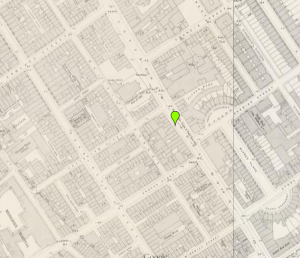
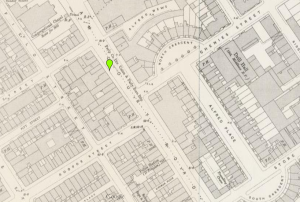
I searched “Tottenham Court Road” in the Charles Booth Online Archive (http://goo.gl/JgRmhL) where it provided this map:
The most prominent colors on the map seem to be red and pink. Red on the map symbolizes individuals who were “middle class” and “well-to-do” while the pink symbolizes those who were “fairly comfortable” and made “good ordinary earnings.” It can be assumed that most of the people who lived in this area owned or worked in a shop in the area, which would provide them with good or excellent wages. However, despite the presence of the middle class, there are small areas where there is greater poverty. Moving a little farther away from Tottenham Court Road, shades of light and dark blue begin to appear on the map, symbolizing the poor, who earned “18s to 21s a week for a moderate family” and the very poor, described as “casual” with “chronic want.”
The zoomed out map appears here:
Even though Tottenham Court Road seems to be a busy commercial destination, it is not a surprise that the strange man with the goose was involved in a row in this area, especially considering it was at a time where most shops might be closed for the evening, meaning there were less people around. The individuals who lived in the poorer areas surrounding Tottenham Court Road most likely loitered these areas at night. Because of the goose the man was carrying, he seems to be a prime victim for poor assailants. Because of this connection to the story and the real-life area, I was interested about what other crimes were committed in this area.
I searched Old Bailey Online (http://www.oldbaileyonline.org) see what crimes were committed on Tottenham Court Road and the areas surrounding it. Many of the crimes committed in this area are relevant to the types of crimes Sherlock Holmes dealt with. The most common crime seemed to be theft with counts of simple things such as pocketpicking to more serious counts of cases like grand larceny and violent theft. There were also counts of murder and sexual assaults in the area, though these were very rare. As unfortunate as it is, It is safe to assume that the theft taking place in the area is due to the road being in close proximity to more impoverished areas. Again, it connects the violent row between the stranger with the goose and the group of assailants.
Overall, this project was very helpful in learning about different areas in Sherlock Holmes’ London, how they were in real life, and what purpose they served in the stories. Some of the sights were easier to manage than others, but all of them had an abundance of information that helped pinpoint specific details about the specific areas and/or landmarks.
Holmes in London Maps
I chose to analyze Cannon Street during the Victorian London era. Cannon Street can be found in the Sherlock Holmes story The Man with the Twisted Lip. In the story, a man by the name of Neville St. Clair who had no occupation but a lot of money was interested in purchasing businesses on Cannon Street.
After using the search tools provided to us, I learned that Cannon Street had a number of murders and other crimes that occurred there in much earlier years. One such event took place on September 6th, 1693. Adam Martyn and Richard Norman Carmen were both tried and found guilty of manslaughter when they drove their carts into a young child resulting in her death (http://www.oldbaileyonline.org/browse.jsp?id=t16930906-6&div=t16930906-6&terms=Cannon|Street#highlight). Another event occurred on Cannon Street on December 10th, 1684 in which a woman named Anne Gardener was tried and found guilty of deception and fraud when she stole rows of silk adding up to 81 GBP (http://www.oldbaileyonline.org/browse.jsp?id=t16841210-35&div=t16841210-35&terms=Cannon|Street#highlight). I also found out that through using “British Histories”, Cannon Street was originally called Candlewick Street based on the fact that many candle-makers worked and lived there.
Another mysterious murder occurred on Cannon Street. In April of 1886, Sarah Millson answered the bell at the business where she worked around 9pm. At around 10pm, a woman who worked with her by the name of Elizabeth Lowes went down to the front door where Sarah Millson was an hour before, only to find her dead and profusely bleeding from wounds on the top of her head. Evidence from the coroner suspects that the wounds were delivered with a crowbar that could have also been used to break into the premises. (http://www.british-history.ac.uk/report.aspx?compid=45065&strquery=Cannon%20Street)
A Case of Identity (Leandenhall Street)
“Father was a plumber in the tottenham Court Road”
My next choice was the Leandenhall Street Post Office, which is where the letters from Mr. Hosmer Angel were addressed to. Street Post Office did not show up on the map, so I cut it down to Leadenhall Street, the street on which Mr. Hosmer Angel worked, and got these results:
The first thing I noticed was the amount of information there was about crimes on or relating to Leadenhall Street. When I searched this location on the “Old Bailey Online,” over 1,100 results came back. While obviously not all these crimes had to take place on Leadenhall Street, and this location may just be a background detail to the case, it does show that the location is not remote.
While going through the “Old Bailey Online,” I’ve concluded that the majority of the crimes that happened on or in relation to Leadenhall Street are theft of some degree.
When searching the Charles Booth Online Archive, I first came across the notebook catalogue. Most of these entries are surveys or questionnaires about businesses regarding pay and working conditions. This leads me to believe that this is not a residential area.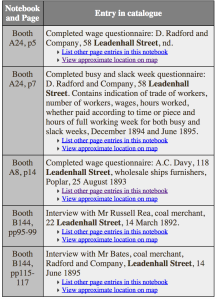
Additionally, I searched the poverty maps on the Charles Booth Online Archive. While I found it was near impossible to find the street on the 1898-99 map, the 2000 map showed the street. Leadenhall Street itself was no colored in, but the surrounding areas ranged from comfortable to wealthy. This shows me that there is little to no poverty in this area. 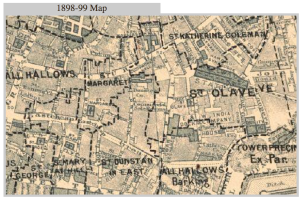
The information I learned during this research drew me to a few conclusions about the Sherlock Holmes stories. One of said conclusions is the accuracy of the locations in these stories. For example, since Leadenhall Street is not a residential area, it makes sense that Mr. Hosmer Angel would work in an office on this street. Moreover, the findings on theft on Leadenhall Street could be interpreted as symbolic. At the conclusion of the story, we find that Miss Mary Sutherland’s stepfather had been impersonating a fellow names Mr. Hosmer Angel in order to ensure that Miss Sutherland doesn’t stop paying him money for things such as rent. Therefore, her stepfather stole her money, her time, and her heart for a brief while.
MALLET Joint Blog Post: Caitlin O’Brien and Lauren Alberti
Lowering the number of topics and iterations in MALLET can make the words found in each topic more general and broad and therefore, much harder to categorize. We found that using a higher number of topics made the terms found in each topic less vague. Higher iterations also helped with getting rid of some ambiguity while looking through the posts and made it a lot simpler to see how the words in each group were related to one another and to the Holmes’ stories themselves.
Three topics we had in common were:
1. Murder:
Lauren: found dead man body blood blow struck knife lay stick head weapon finally wound unfortunate bullet handle lying acted fainted (70 topics, 1000 iterations)
Caity: found man body blood dead knife lay stick blow head carried weapon heavy finally unfortunate neck wound lying drawn struck (100 topics, 1000 iterations)
2. Time/Time Measures:
Lauren: hour half past clock time cab ten waiting quarter work wait late minutes back drive catch eleven immediately presently church (70 topics, 1000 iterations)
Caity: time years week ago year country months days age twenty (50 topics, 2000 iterations)
3. Writing:
Lauren: paper note letter read handed wrote written writing sheet write book post page began pen pencil slip ran printed torn (100 topics, 5000 iterations)
Caity: paper note read letter table book papers pocket letters written (50 topics, 2000 iterations)
The topic of murder is found the most in “The Abbey Grange” and the least in “The Red-Headed League.” The topic of Time/Time Measures is found the most in “The Five Orange Pips” and the least in “The Illustrious Client.” The topic of Writing is found the most, again, in “The Five Orange Pips” and the least in “A Scandal in Bohemia.”
These are two question we proposed about the data:
1. Is this information important or useful to historians that are studying the time period in which the Sherlock Holmes stories were written?
2. How does the changing context of these stories change our interpretations of the data?
Topic Modeling MichaelF
3 Topics from first search (50 topics/ 1000 iterations/ 15 words printed)
1- (Hallway) door room opened open heard key light sound passage stood inside closed hall entered locked steps pass lock dressing stair
2- (Communication) asked friend gentleman mine round godfrey back client fine strong word laughed telegram turn match news rucastle laughing staunton rough
3- (Study/Office) small pocket put study drew cut papers attention eye safe examination bird piece left cigar mark thumb finger seat interest
3 Topics from second search (25 topics/ 500 iterations/ 15 words printed)
1- (Case) inspector colonel crime fact remarked evidence present points train murder observed important follow complete mystery
2- (Suspect) face man head hand dark black cried instant turned white suddenly figure opened quick sight
3- (Evidence) note letter men short word letters handed fashion means written answered writing strong wrong message
4 Topics from third search (20 topics/ 250 iterations/ 10 words printed)
1- (Suspicious) man face eyes head dark hand half deep figure dog
2- (Location) night morning hour made note told brought box clock lord
3- (Discover/Trace) window light black lay side walked led floor corner close
4- (Attack/Violence) woman cried hands hand moment suddenly face instant feet voice
Ngram’ing Information
The first two terms I looked up Google Ngram Viewer were “literature” and “film”. I thought this would provide interesting results, due to the ever present debate on films verses literature, and I was right.
Both terms are getting increasingly popular, and what I find most interesting is that even though “literature” (thankfully) came out on top, “film” is almost at the same number, and it got there in a very short time-spam. In this digital age, it is good to know that literature is still more popular, at least according to Ngram. While literature has been around a lot longer than film has, it is interesting to see how it still has a positive, increasing slope. Even though according to the graph, there were “dips” in popularity, literature still has sustained increase. Whereas film has gone nowhere but up, but of course that is to be expected. Ever since mainstream films, or movies, popularity has only gone up. Everyone has a favorite movie, not everyone has a favorite book. I suspect that in the next few years, film will surpass literature on this graph, maybe it already has, as Google Ngram data isn’t currently up to date.
For my second comparison, I used the old saying “The pen is mightier than the sword”. In this case, the pen IS mightier than the sword, but the sword was mightier than the pen for a really long time. This graph kept surprising me. The first time was when I realized how popular both sayings were at first, then to see the shrinking popularity of the terms over time. Then of course at the end I was shocked to see that pen did indeed win in the end. Swords were the weapon of choice before guns were widely used, so of course in the writings of that time, people used swords. Also a big part of early literature was the detective novel, where a pen might be used. Often in a book or work of writing, someone would be writing, for it is a common thing, so that’s where the word pen might be used. Nowadays, the fantasy and science fiction novels that are on the market are moving away from the past, and into the future. In those scenarios the characters wouldn’t use swords, but a gun of some sort, leading to the falling popularity. In other types of novels, modern day technology is seeping into books, so where a character would usually write something down with a pen, they might type it, leading to the falling popularity of that word as well.
